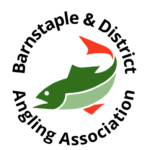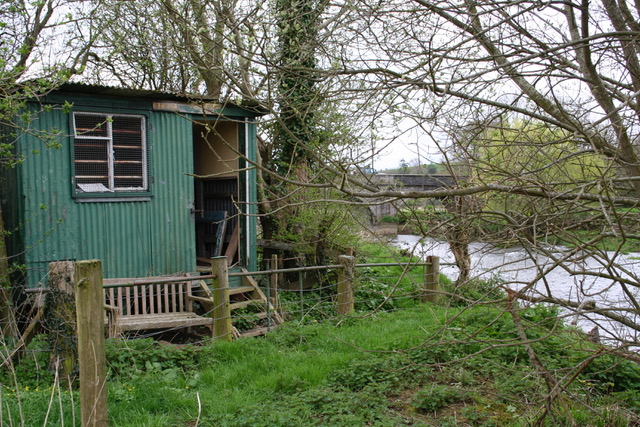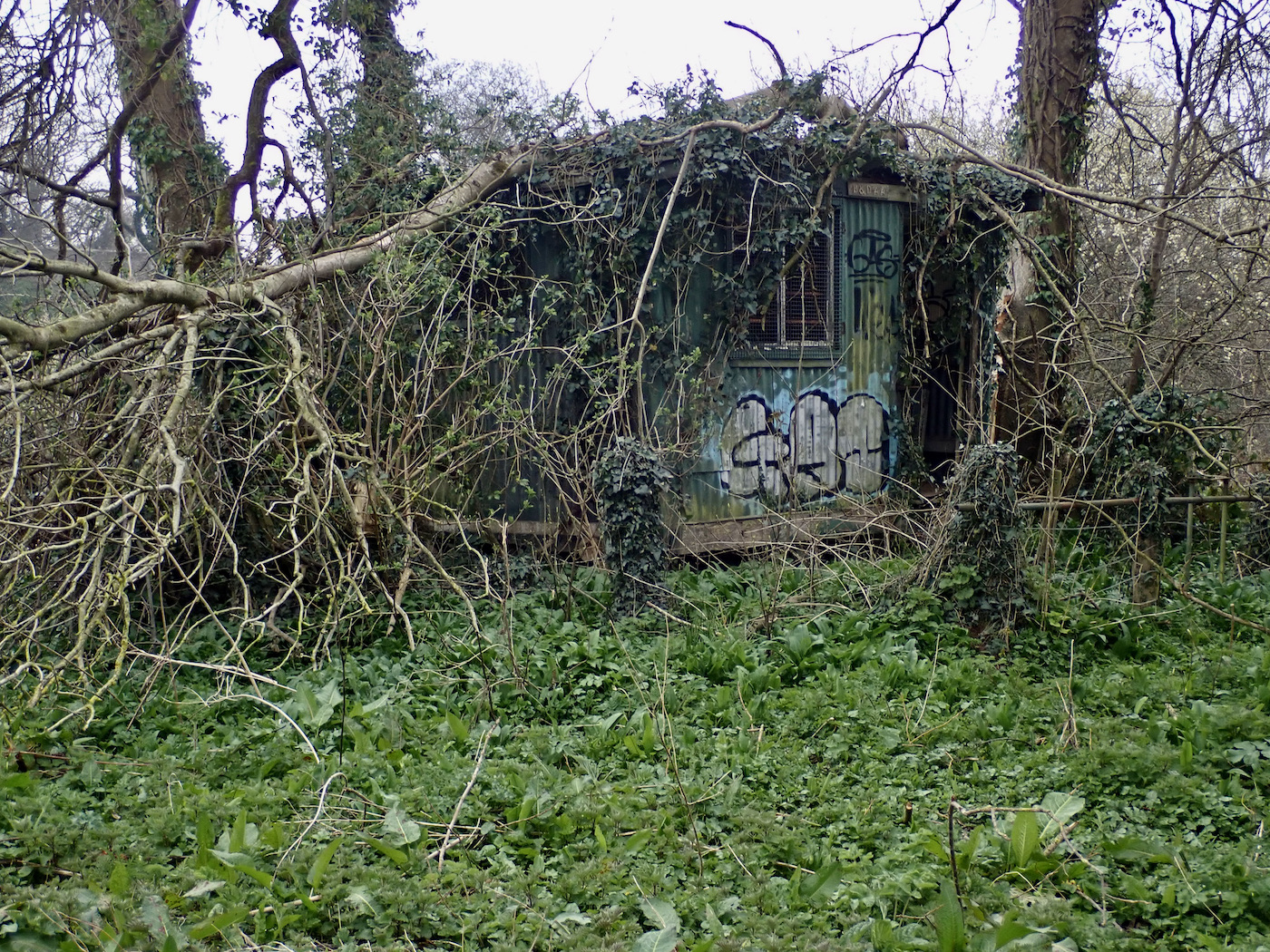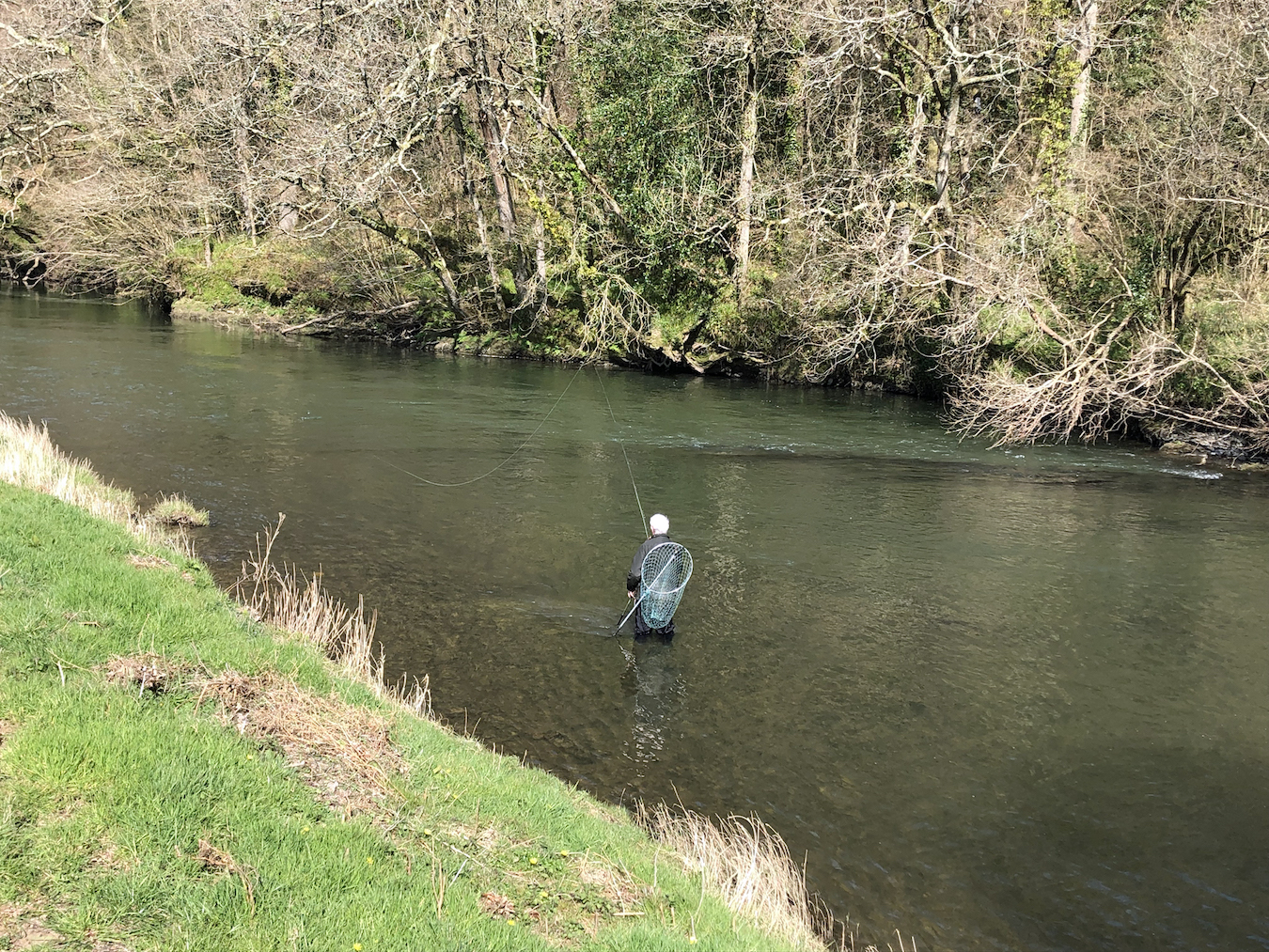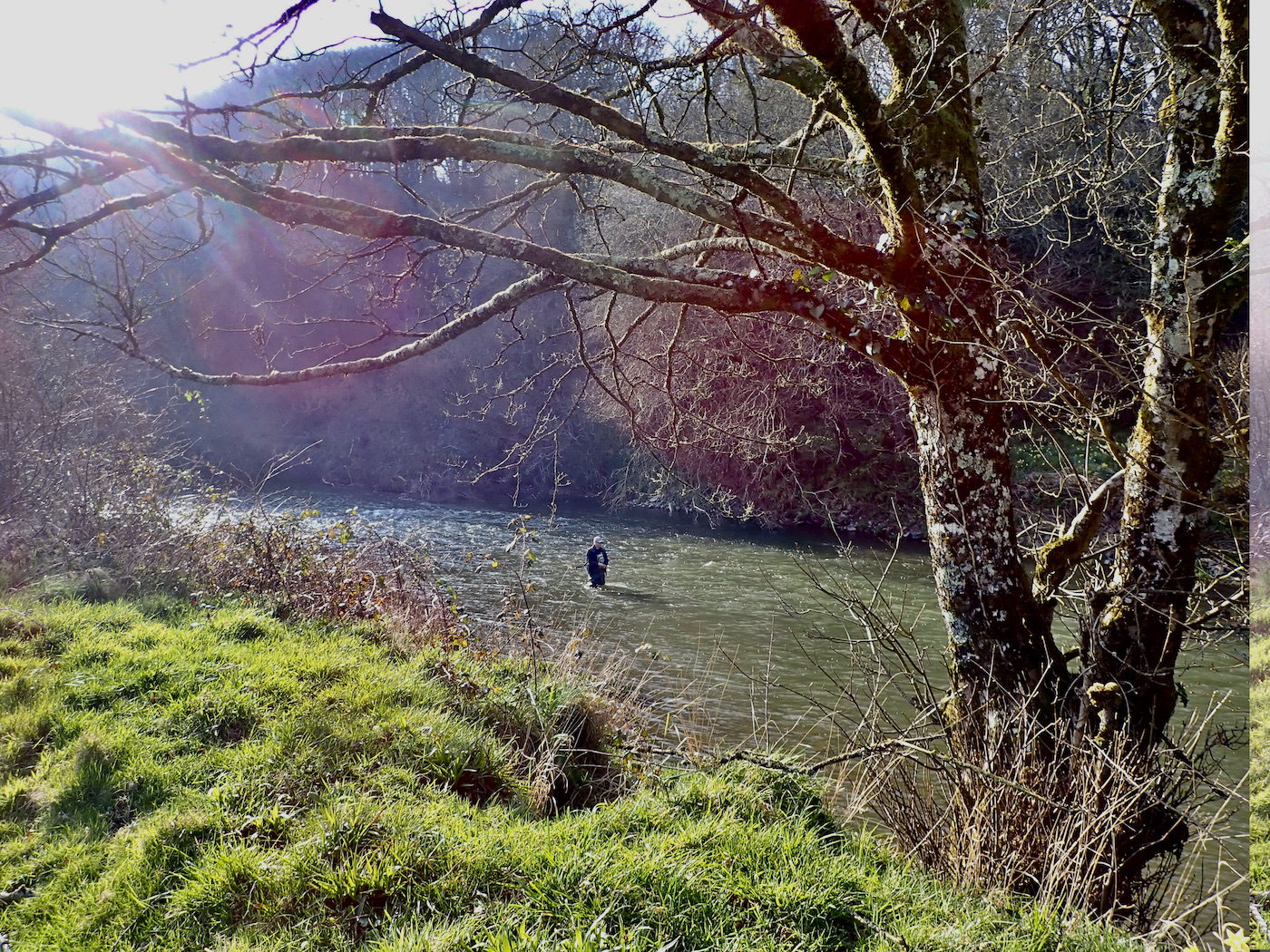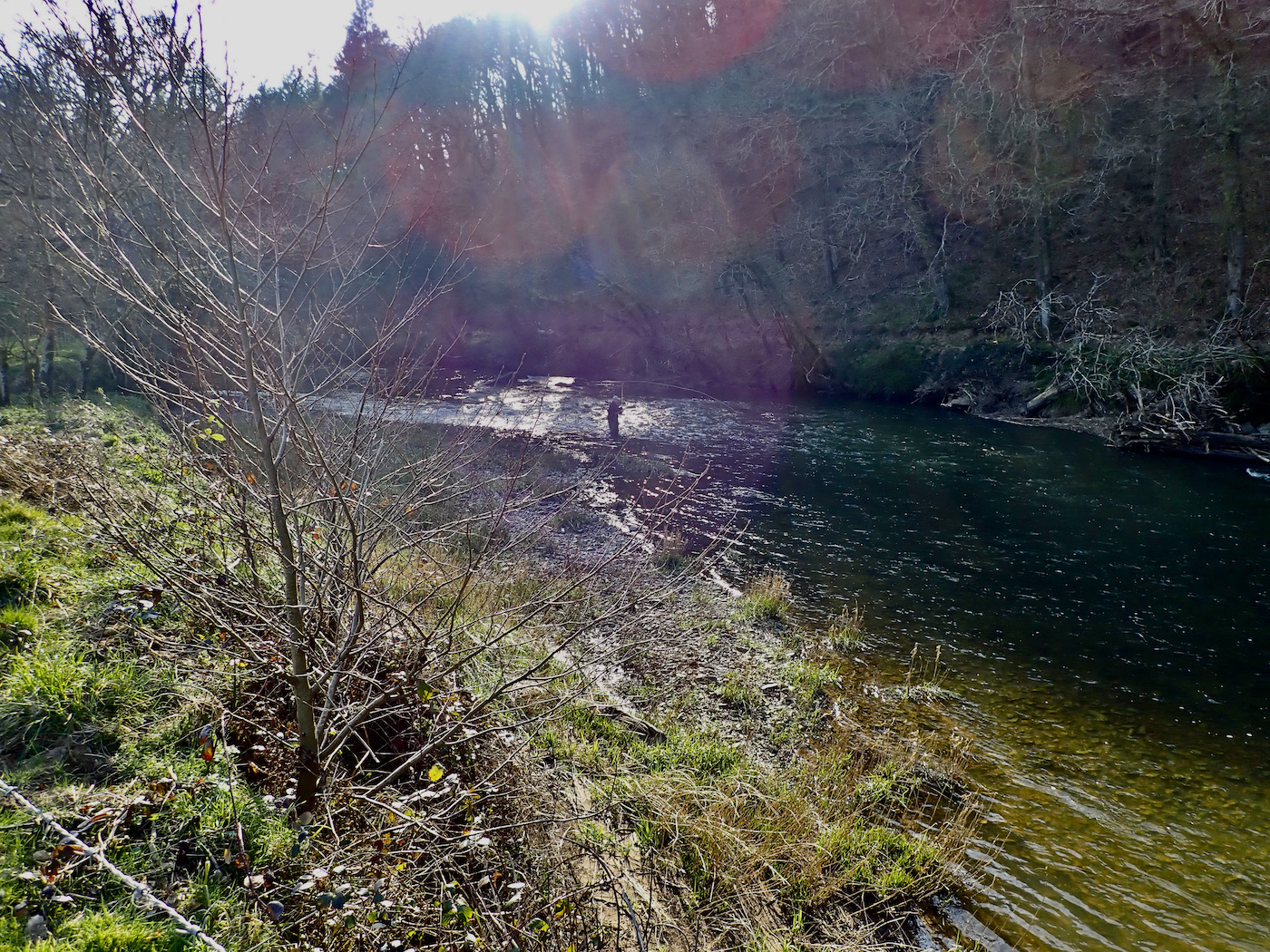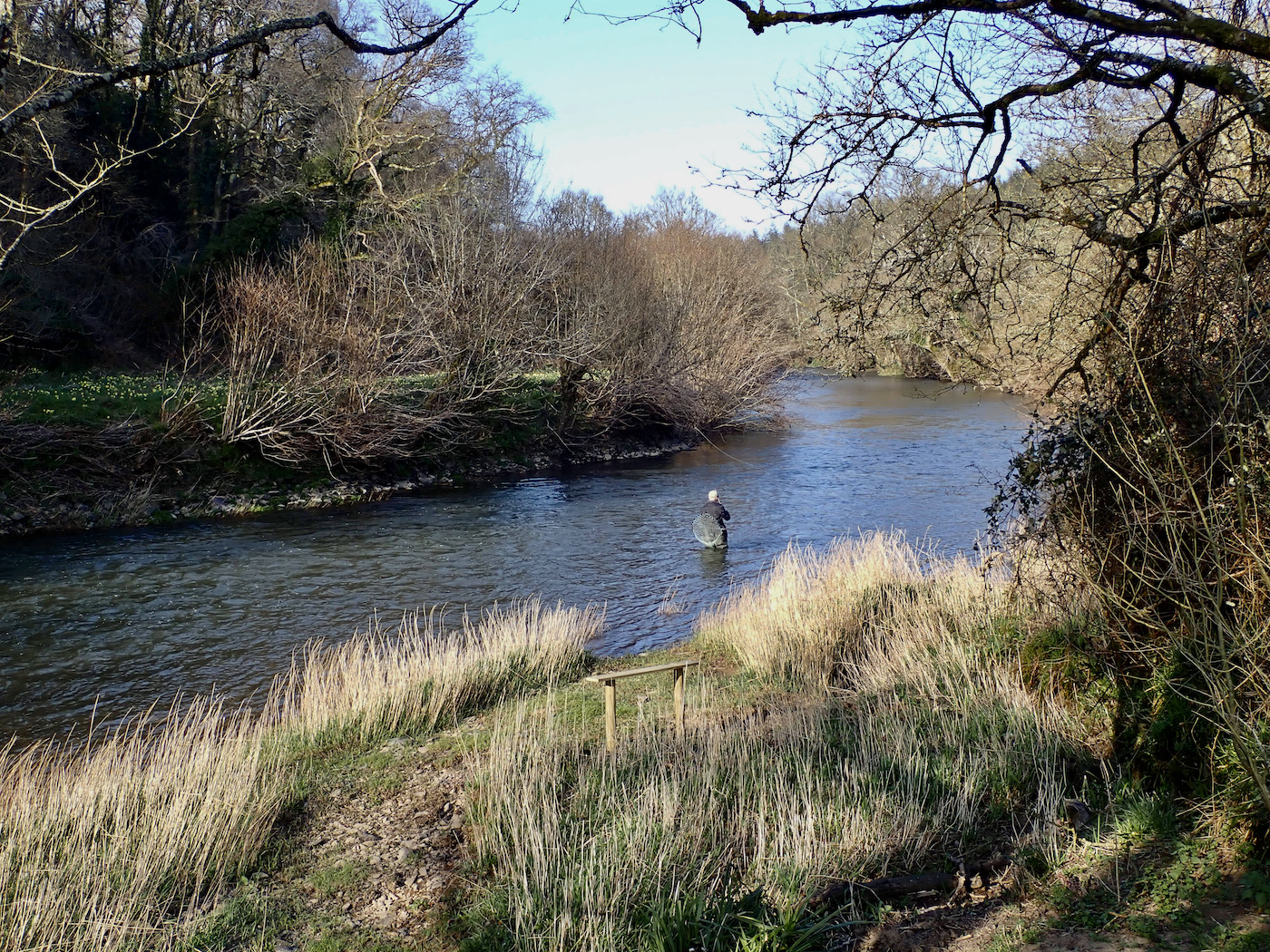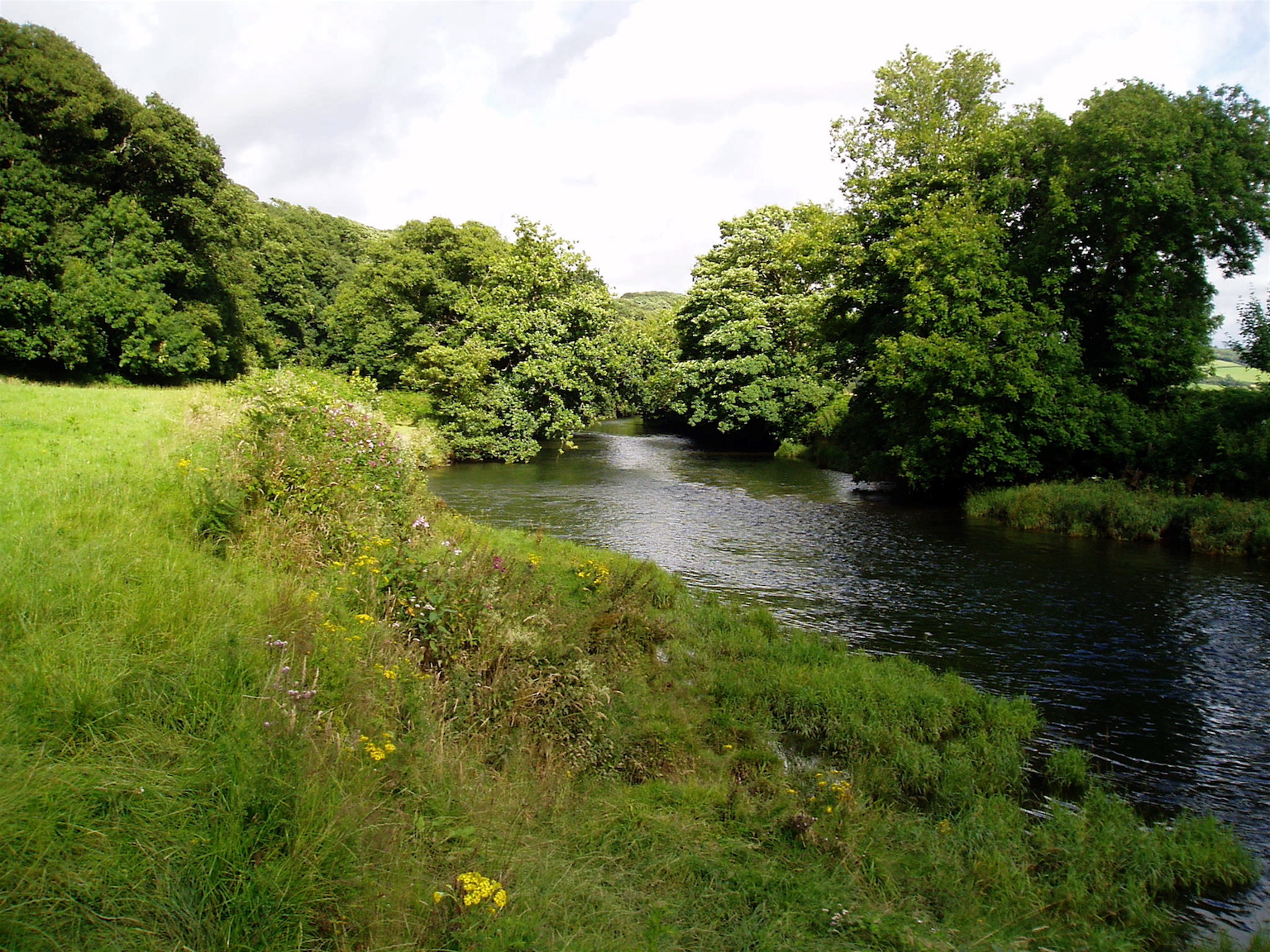Andy Gray
Chairman’s Report 2021 Salmon: 66 Sea Trout: 129 We are all licking our wounds after a particularly poor season for migratory fish on our system. The water heights were often not helpful. The worrying part of the story is, when we did have good water, fish numbers were still low. The reports from the estuary were not encouraging either. Is this a particularly bad year amongst an ongoing set of poor years? Recognizing trends, is easy, but identifying causes less so. Our fish have complex life cycles in complex landscapes. Add the unfathomable influence of the sea and then understanding and interpreting the cause of this downward trend is well-nigh impossible. Influencing and arresting the decline, more so. We are not alone, all the rivers in the southwest are experiencing the same ongoing decline. We have science proving that siltation suffocates fish eggs, often all the eggs in effected gravels. We have observed a step change in soil run off in recent years, especially driven by the increase in maize in our catchment but also due to a general decline in soil health. Hence our work gravel washing. We are also continuing fry surveys, and these may help interpret the result of this initiative. We are aware of increased phosphate pollution partly from sewerage, partly from agriculture. Phosphates directly affect water quality and therefore how productive our river is. These are national issues, requiring national solutions. As an organization we have vociferously added our voice to countless others lobbying on these issues.
What changes can we expect and how soon? The sewage problem has just reached some form of resolution. The new environment bill has changed the environmental framework the water companies work within and has tightened the screw slightly. They have to move more rapidly towards solving the storm overflows, and also provide more data on their polluting activities. There are more improvements needed. Alex and Ian did a lot of work on South West Waters (SWW) PR19s last year. This is a review on sewage treatment works (STW) capacities, identifying which STWs need the most work and then having them recognized in SWW 5-year investment plan. South Molton on the Mole, Chulmliegh, Winkleigh and Bow, on the Upper Taw were all identified and will receive investment. These investments should help protect our water quality. So, we have progress on sewage. The effect of these changes will not be immediate. Farming – There is an increasing recognition that many practices are unsustainable. This recognition is leading some farmers to adopt regenerative techniques to improve soil health. Others will not do this unless induced by payments or beaten into change through properly enforced legislation. We are living through an example of improved enforcement right now. The EA have finally decided to enforce the existing manure spreading legislation. This is leading to howls of protests from farmers, especially over “autumn spreading when there are no proven plant requirements”. The farmer’s argument is the nutrients are absorbed by the soil in readiness for plant requirement in the spring, the EA, that the nutrients will leach into ground water and run off into rivers if not assimilated by plants soon after spreading. We have had two legal disputes running on our river over damage caused to the system. Alex will give you the details in a short article later in the newsletter.
The Environmental Land Management Scheme (ELMS) is still being formulated. This is the payment system replacing existing direct payments for owning land. It will require land-based public good in return for government payments. If the right schemes are implemented, we could see a dramatic improvement in water quality, but don’t hold your breath… Carbon trading and biodiversity offsets could well have a more beneficial effect on our landscapes and rivers. They may channel money from polluting industries and travel into paying landowners to use their land in ways that improve the quality of the water draining from it. These changes will take time to filter through and help our beleaguered salmon and seatrout, but there are some positives in an otherwise troubled picture. Andy Gray Chairman
River Taw Byelaws Seasons Salmon 1 March to 30 September Sea Trout & Brown Trout 15 March to 30 September Methods Fly fishing permitted all season Spinning for salmon only permitted until 31 March No other method or bait fishing permitted No rod caught salmon or sea trout to be sold or offered for sale Salmon No salmon to be retained before 16 June No salmon greater than 70cms in length to be retained after 31 July Sea Trout Size limit 25cms Brown Trout Size limit 20cms RTFCA Strongly recommends that you practise catch and release whenever possible.
West Country Rivers Trust
Electrofishing Fry Index Survey Taw Catchment The 2021 Index Survey, funded by our association, is n all honesty is not pretty reading. We will circulate the report in its entirety in due course as it provides interesting reading. However, set out below is a summary The Westcountry Rivers Trust (WRT) undertook a number of semi -quantative fry index electrofishing surveys in the River Taw catchment in August and September 2021. Electrofishing uses a controlled electric current to induce fish to swim toward an anode and into a hand net to be counted and assessed. The aim of the programme was to identify the issues that prevent salmonids from effectively completing their life cycle.
The WRT surveyed 40 semi-quantitative sites on the Taw. The survey identified that the Taw catchment does have the potential to support salmonid spawning of varying quality and indicates the importance of the main river stem and tributary spawning sites for salmon and trout reproduction. Salmon Fry Results Out of the 40 sites surveyed only seven were classified as A ‘Excellent” and four were found to be ’B’ of ’Good’. This then equates to 11 out of 40 or 27.5% of sites being at an acceptable level of recruitment for salmon. Worryingly of the 40 sites tested 11 showed no signs of salmon fry at all, 27.5%. Whilst this makes for bleak reading it is to be noted that of these many did not show salmon fry in 2016. The sites that have deteriorated are restricted to; · Fox and Hounds, Taw (D-E) · Nymet Bridge, Lapford Yeo (D-E) · Huntacott Bridge, Huntacott (D-E) · Milltown Bridge, Little Silver Stream (D-E) There is good news, however, of the 33 sites surveyed that had been surveyed before 17 show signs of improvement in salmon numbers. This suggests that the vital work of our association is making headway. Even more encouraging is Yeo Farm on the River Yeo, Molland which has improved from B ‘good’ to A ‘Excellent’. This site has had gravel cleaning works performed in 2021 and has been cleaned in the last three seasons. This shows our work is having a beneficial effect.
Trout Fry Results Trout fry appeared to fare less well than salmon in the sites surveyed. With no sites across the catchment being classed as ‘A’, ‘Excellent’. Trout fry were absent from 19 sites out of the 40 surveyed. Whilst concerning, hope is found in that 7 sites have shown improvement between 2016 and 2021.
Going Forward It is clear that we need to repair trout fry habitat in all waters in the Taw catchment. As regards Salmon while the Bray and the Upper Taw are in good condition there is a great deal of work to do on the rest of the catchment.
The Return of the Shad Five years after the completion of the River Taw Access Over Weirs project, evidence is building of its growing success. In 2007 The River Taw Fisheries & Conservation Association ably supported by and in partnership with the Westcountry Rivers Trust, the EA and others began a catchment wide programme to improve access for migratory species over a series of man-made obstacles – mostly old industrial mill weirs that were either impairing or blocking access for migratory fish species. The aim was to ease passage up and downstream thus enabling better access to spawning and improve the recruitment of juveniles. Although the work was primarily aimed at important keystone species like salmon, sea trout and brown trout, it was hoped that the project improvements would benefit other important migratory species such as sea lamprey, brook and river lampreys, the red listed European freshwater eel as well as the resident coarse fish population.
Between 2007 and 2015, twelve weirs were either removed entirely or improvements and easements made to allow fish easier access over them. Some of these obstacles were truly enormous, requiring substantial fundraising efforts and major engineering works to get them out. Some were all but impassable in anything other than very high flows. In the Spring of 2011 and 2012 observers began to report that game fish were turning up in parts of the catchment much earlier than they used to. Moreover, river watchers reported sightings of sea lampreys spawning on the River Mole and Bray above the now removed weir at Head Mill. These were the first sightings of this species in this part of the river catchment for generations. Sightings continue to be made both in this part of the catchment and now elsewhere.
But other things now appear to be happening beneath the surface. There have long been historical reports of twaite shad and perhaps its larger relative – allis shad being caught in nets in the shared estuary of the Taw and Torridge. Perhaps, in the dim and distant past the Taw system had its own spawning population before they were largely extirpated by the erection of weirs in the industrial revolution. Twaite and allis shad are relatives of the herring. They live in the sea, migrate upstream to breed in freshwater and their young migrate downstream to the salt to grow. They are a rare fish in the UK.
But now it seems shad are turning up in the Taw catchment and the most amazing thing is they may be spawning in the river and its tributaries. In the late spring of this year, two shad were caught by salmon anglers, one at Watertown on the Mole: two miles above Head Weir, a barrier formerly impassable to shad and the other in the Taw above the junction pool. Both were males and both were in spawning condition. The anglers immediately recognized the species as protected and the shad were therefore returned unharmed to get on with nature’s important business. This follows previous reports of shad caught and released in 2020 and 2019.
As an Association of anglers and conservationists we should be hugely encouraged by this turn of events. It could be that by helping to open up fish passage on the Taw catchment we have, perhaps inadvertently, assisted a rare and endangered fish to re-colonise a river system that it once may have flourished in. Shad spawn in late May and early June and the process is described as a frenetic affair. With males chasing females through the shallows on the tails of pools where the eggs are released and fertilised and allowed to drift down onto fine gravel. There is often a substantial amount of splashing as the shad announce their presence. If you should catch a shad, then please treat it carefully. If you can photograph it then please do and if you can include an indication of scale and size, then even better. Then release it carefully and unharmed. Please report any captures or sightings of shad spawning activity to the Chairman [email protected] or Secretary with accompanying photos as we may be able to put together a case to secure funding in order to be able to help this endangered species and improve the health of the river still further. All of our members are fishers and conservationists at heart and these reports represent a new and exciting chapter in our efforts to secure the future health of the river. Only time will tell but this could well be another successful outcome in the journey to return the catchment to more sustainable and natural state.
Ian Blewitt
Update from the South West Rivers Association SWRA is the voice of riparian owners and game angling in the South West. It is the umbrella of the individual river associations in the South West and a powerful lobbying body regularly consulted by the Environment Agency and Government. This is my last contribution to the Taw Association’s Annual Newsletter as I (finally!) retired at our AGM in October. However SWRA is in the excellent hands of my successor William Entwisle a retired senior naval officer, keen angler and much younger! It’s also an opportunity to thank Alex Gibson for the support he has given to SWRA and the Taw and welcome Andy Gray – another younger man! William has reviewed the way SWRA works and, with the unanimous support of our Council, has instituted a small Executive Group to focus on work strands of highest priority. The Annual National Salmon Stock Assessment and Angling Trust Salmon Angling Advisory Group William is joining the reformed Advisory Group which will work with the EA to ensure a more robust and reliable assessment of salmon stocks in each river. This is a key element in determining appropriate voluntary and mandatory control of angling – we are committed to the former as the best means of protecting our interests and maintaining a high level of interest in the future of salmon.
As I write Defra’s formal public consultation ‘On Approach to Beaver Reintroduction and Management in England’ is live with a closing date of 17 November. SWRA’s response will focus on the threat of unrestricted beavers to salmon and sea trout migration to and from spawning areas using a detailed report commissioned from Professor Ian Cowx of the Hull International Fisheries Institute. In particular we shall be seeking for the easy ability to manage beavers and their dams without excessive regulatory bureaucracy. Our response will also be available to the Taw Association as a template. Cornwall IFCA Salmonid Byelaw Consultation Unlike Devon, where SWRA and the TFA worked closely to ensure a good byelaw to protect salmon and sea trout in inshore waters, the Cornwall IFCA’s proposals are inadequate and much weaker than originally presented. They matter as fish destined for the Taw are known to pass through Cornish waters. SWRA will be lobbying robustly for a byelaw similar to Devon. Regional Water Resource Planning SWRA has a seat on the stakeholder group set up to influence the three water companies (South West, Wessex and Bristol) charged by Defra with producing a plan to ensure adequate supplies for the next 25 years. This is to take account of predicted population growth, the effects of climate change and the need to protect river flows. We are not aware of any plans affecting the Taw will
Water Quality After a long delay caused by COVID restrictions SWRA’s meeting in October had a presentation from Alan Burrows, SWW’s Director of Environment and Culture, on the company’s approach to sewage treatment and sewer management, a topic on which RTFCA has lobbied strongly. Although he stated that sewage only caused 1.5% of poor SW river quality compared to agriculture’s 48% he acknowledged the need for better performance, especially on the growing number of discharges on untreated sewage from storm overflows. A significant problem often raised by the RTFCA is unrestricted population growth with no consideration of the impact on sewer/sewage treatment capacity – Alan explained that Planning Authorities no longer have a duty to consult the company on new developments and that developers have a statutory right to connect to the company’s sewers.
Access and Canoeing We continue to work with Angling Trust/Fish Legal to put pressure on Canoe England to withdraw their misleading opinion about access rights which fly in the face of the settled law that there is no general right of public navigation on rivers. There is little hope of progress.
Regional Hatchery Three rivers are now taking advantage of SWW’s willingness to support the salmon hatchery at Colliford on the Fowey. There is good evidence that climate change is having a negative impact on salmon with high winter temperatures causing low survival of egg and alevins. The warm winter of 2016 is known to have severely reduced juvenile salmon numbers in several Welsh rivers and such winters are predicted to become more frequent. It is probable that taking stripped fertilized eggs to a hatchery with chilled water may be the only way of bridging this block to successful natural recruitment. SWRA will continue to develop the concept of a regional hatchery and lobby the EA for a change in policy Roger Furniss Outgoing Chairman SWRA One of the most important aspects of the Westcountry CSI scheme is that through the increasing number of people closely watching the rivers and streams we are more likely to spot pollution incidents and enable them to the be reported to the environment agency. The Environment Agency is the responsible body for recording and responding to pollution incidents in England. It has a dedicated incident hotline that you can call 24 hours a day 7 days a week.
0800 80 70 60 [email protected]
By kind permission of Pete Tyjas, Editor in Chief, Fly Culture Magazine – Extracts from an interview with Mikael Frodin speaking to the magazine about open cage salmon farms and the impact they are having. Mikael Frodin is a Swedish fisherman, author, the pioneer of the SALAR series of hooks and spends most of his time behind the vise devoted to finding “The perfect tube fly”. Through his writing, blog and social media he has worked against overfishing, hatcheries and fish farming problems. His commitment to conservation is evidenced by hid guiding philosophy. Any wild fish are worth more than a million hatched—any ecosystem is worth more than all the money in the world” Do you feel a greater sense of responsibility, as a famous salmon angler, to take action on conservation? The older I get the more time I spend with conservation. Maybe also because the older I get the fewer wild fish are left to fish for. As an angler I have a responsibility, as a pro angler I have an even bigger one. I spend more time on rivers and get a wider personal perspective. I cannot just say that things are wrong and that it is for others to change. I believe, and maybe also proved, that as individuals we can make a difference. We must take action and say when things are terribly wrong.
In the UK there is still resistance to conservation measures, while the Environment Agency continues to lose both funding and teeth? Do we now need tighter regulations such as barbless hooks and compulsory catch and release? – Even if it means some anglers stop salmon fishing? I think that catch and release is wonderful. We can have our cake and eat it too. We can build a sustainable eco-tourism around salmon fishing without negative effects on the wild stocks. We have to keep on reminding politicians about the fact that a dead salmon for food is worth a few pounds and that a salmon caught on a rod is worth 100 times as much for society. We have to be even stronger telling the truth around the fish farming industry. The three most important reasons for the decline of wild salmon stocks all come from fish farming: spreading of disease, sea lice problems and genetic pollution from fish farming escapees. If we don’t change the direction of the industry, if they don’t clean up and move into closed containments – we will have lost ALL wild salmon stocks. Very soon! Some of the larger donors to some salmon conservation charities are involved with aquaculture. Is that an untenable position now we know the damage fish farming is doing? The more the right people are involved in the industry the better it is. We need help to have the change into closed systems happen fast. If people clean their dirty conscience by supporting sustainable environmental movements without really caring about the damage – they should be ashamed and we should put the lights on this. We need powerful help from inside the business or from powerful investors saying they will support what’s sustainable and not an industry that will be the reason for wild salmon stocks to go extinct.
It has been suggested that closed containment farms may become the primary method in Scandinavia. Does that offer a solution to the crisis? Yes, I think so. Closed systems give control. There is no genetic pollution, no sea lice problem, no spreading of disease to wild stocks, no waste problem. The problem without fishing the ocean for food will still be there but some of the urgent problems will disappear and this will change the course and save the wild stocks. This MUST happen and it is very urgent. If we wait another couple of decades all stocks of wild salmon will be extinct. What took evolution hundreds of thousands of years, the fish farming industry has destroyed in three to four decades. The industry knows that fish farming will end up in closed containments. We need to make sure that the change will be fast.
In the UK we have seen direct action on environmental and conservation issues, from Extinction Rebellion to striking school children, yet the majority of people remain unaware and uninterested. How can we get regular people on our side? – And how can we put genuine political pressure on our governments? I believe in the power of the people. We who know the problem must take the fight and use some of our time to educate the public. Politicians too of course but if the public will be aware, the politicians will follow – this is the good thing about democracy. The politicians need to have the people behind them. I am absolutely sure that the public will change and will not eat farmed salmon or support the industry if they are aware of the effects on the wild fish and also the negative impact on our health. We need to use our fishing channels, mags and TV, social media and local papers. We need to spread the word about the environmental crisis caused by the fish farming industry . We need to scream and shout it out loud so as many as possible hear us! Who would want to support an industry with a mortality rate of 25%, what farmer would get away with that? 53 million farmed salmon died inside Norwegian fish farms in 2017. It’s an outrageous animal cruelty crime that the public have no knowledge about.
How do we reconcile the global need for greater food security with a conservation-minded approach to aquaculture? We need to spread the European Food Safety Authority regulations. Regulations showing that farmed salmon is not a food source that will lead to a healthier population – quite the opposite. We need to question why we should be able to eat salmon seven days a week, 12 months per year. Salmon is a seasonal food source. When the fish come into our rivers we can fish a certain percentage and let the rest spawn. We can do this in a sustainable way. And we should know that it can be done only a couple of months a year. The reason for us to think that we should eat salmon all year round and as often as possible is ONLY because the industry wants to make as much money as possible. We are fooled to think this is natural and generally don’t see that we are victims for the massive fish farming PR machine. We need the industry to be sustainable and society to demand that. This is to respect future generations. At what point do we need to consider a moratorium on salmon fishing? Should we stop chasing a fish that is in so much trouble? Again – we are the solution. The catch and release-based ecotourism generating more money than the commercial fishing is a powerful tool that should be used to protect the wild stocks. A moratorium ends up in poaching and forgotten rivers. I have no belief in that. Do you think away from fishing that the general public are being engaged about salmon farms? The general public have no idea of the problems. They don’t see fish farming as a threat and they don’t know that wild stocks are on the way to extinction because of this industry. We need to educate and teach people what’s going on before it’s too late.
Petitions are great but do you think they actually have an impact? I do – if we can hand over one million signatures to the responsible ministers they need to listen! The power of the people works this way and also through the consumers. If the consumers don’t buy farmed salmon the industry will change. Pete Tyjas
River Taw Fisheries Association Committee Chairman: Andy Gray Secretary: Ian Blewitt Treasurer: Richard Nickell Lower Taw: Peter Tyjas, Charlie O’Shea, Mark Maitland Jones Upper Taw: Simon Phillips, John Smith, Gordon Murray River Mole: Andy Gray, John Macro, Chris Taylor Former Chariman: Alex Gibson IT Advisor: Brian Martin Torridge Representative: Paul Ashworth
Sea Trout Studies We reproduce the following two articles for you showing the studies currently underway. Our understanding of sea trout behaviour is very limited. Hopefully the knowledge gained in these studies will help inform netting regulation and further protect sea trout at sea. SAMARCH Projects on sea trout. Tracking of salmonids through estuaries and coastal waters Dr Céline Artero In spring 2018 and 2019, project scientists with the support of the Environment Agency tagged 359 sea trout and 457 salmon smolts with acoustic tags on the Rivers Frome and Tamar in the UK and Rivers Scorff and Bresle in Northern France. This is to investigate their migration speed and mortality rate through the lower river, estuaries and out to sea. Each winter since 2017 we have tagged a total of 314 seat trout after they had spawned in November and December (known as kelts), as they migrate back to sea with Data Storage (DST) and acoustic tags. The acoustic tag will tell us when they left the river and when they return to the same river to spawn again.
SUMMARY FINDINGS SMOLT TAGGING Detection loss of smolts was gradual along the estuaries and no specific areas accounted for pronounced increases in detection loss. Further analysis is ongoing to assess the acoustic detection efficiency and smolt mortality along their migration through transitional waters. · Estuarine detection loss of smolts varied between species and study sites but remained relatively constant between years. · Detection loss was higher for salmon than sea trout smolts. · To date, 26% of the deployed DST’s have been recovered. 10% from recaptured fish in traps and by electrofishing and 16% have been found on beaches. · The tagged sea trout exhibited a strong diving behaviour reaching depths of up to 80m. However, the pattern of this diving behaviour appeared to vary between study sites and by time of day. · 27% of our sea trout kelts died at sea from predation. Recovery of the DST tags will give us information on the migration routes and behaviour, including their swimming depth, of sea trout while at sea. This information is crucial to advise the management of commercial netting at sea to better protect salmon and sea trout. The sea trout were tagged in the River Bresle in Northern France and the Rivers Tamar and Frome in the south of England. So far we are recovering some 26% of the tags through electric fishing the sea trout when they return to the river, being found on beaches or using the Environment Agency trap at Gunnislake on the Lower Tamar and the Agency of French Biodiversity trap on the lower Bresle
Trout genetics – to create a genetic database for trout in rivers in the Channel area and a map of areas important for sea trout at sea By Prof Jamie Stevens, Dr Andy King & Dr Sophie Laurney In the summers of 2017, 2018 and 2019 some 2000 samples were collected from juvenile brown trout along 80 rivers in the channel area to develop a data base of trout genetics. Samples were collected in England by Environment Agency teams in the south of England. In the summer of 2019, under dispensation from the Environment Agency, the project set fixed gill nets to catch salmon and sea trout around the coast of Cornwall and Dorset. This was to collect samples for genetic analysis to monitor movements of fish by comparing their genetics and marine location to the genetic data base. On average 1.7 sea trout were caught per 600m of gill nets set each evening an d recovered the following morning SAMARCH (2017 – 2023) is a seven-year project that will deliver practical tools for management to better protect salmon and sea trout in coastal waters. SAMARCH has 10 partners, five from England and five from France and is led by the Missing Salmon Alliance (MSA) Partner, The Game and Wildlife Conservation Trust (GWCT) and has a budget of £9m which is funded 69% by the European Union’s Interreg France England Channel Programme. www.samarch.org.uk
Legal Matters Upper Taw After the EA took no legal action against a farmer who had dredged a section of his beat, Chris Lynden, the riparian owner, supported by RTFA, put the matter in the hands of Fish Legal. The long-running case was issued at court, but settled before it got to trial, allowing both parties to resolve their dispute and work together in the future for the management and protection of this important section of the Upper Taw. Details of the settlement remain confidential. Mole Following the EA’s successful prosecution this year of those responsible for polluting a 4.7 km stretch of the River Mole with anaerobic digestate, RTFCA has put the matter in the hands of Fish Legal with a view to taking legal action for damages. Proceeds will go towards remediation work on the Mole. The pollution incident took place in July 2019. At the time more than 9,000 dead fish were recorded, including salmon, sea trout, brown trout, bullheads, stone loach and minnows. The total number of dead fish was estimated to be around 11,600 with whole populations of salmonids from mature adults to fry wiped out. To support our private action the necessary data is being gathered. This will include the original EA Fish Kill Technical Assessment and rod catch information as well as historical EA juvenile surveys and Westcountry Rivers Trust fry index surveys. RTFCA’s membership will be kept informed as matters progress. Alex Gibson



